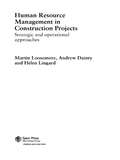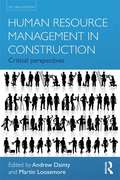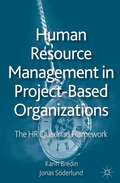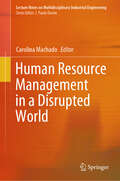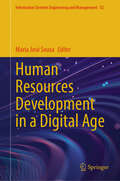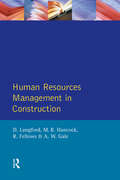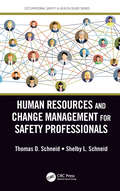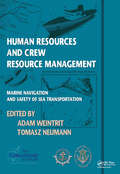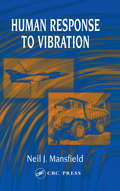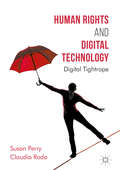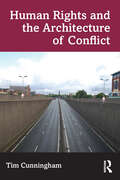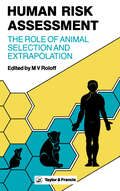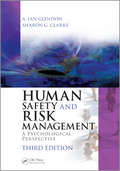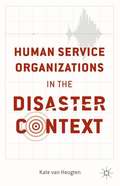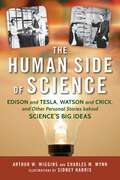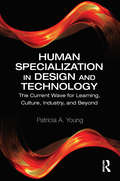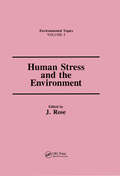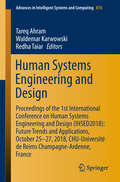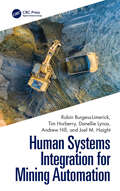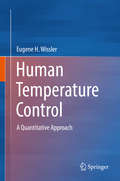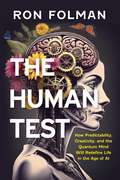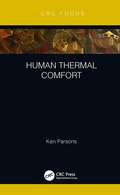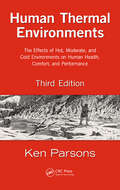- Table View
- List View
Human Resource Management in Construction Projects: Strategic and Operational Approaches
by Martin Loosemore Andrew Dainty Helen LingardAlthough construction is one of the most labour-intensive industries, people management issues are given inadequate attention. Furthermore, the focus of attention with regards to HR has been on the strategic aspects of HRM function - yet most problems and operational issues arise on projects. To help redress these problems, this book takes a broad view of HRM, examining the strategic and operational aspects of managing people within the construction sector. The book is aimed at project managers and students of project management who, until now, have been handed the responsibility for human resource management without adequate knowledge or training. The issues addressed in this book are internationally relevant, and are of fundamental concern to both students and practitioners involved in the management of construction projects. The text draws on the authors' experience of working with a range of large construction companies in improving their HRM operational activities at both strategic and operational levels, and is well illustrated with case studies of projects and organizations.
Human Resource Management in Construction: Critical Perspectives
by Martin Loosemore Andrew DaintyThe construction sector is one of the most complex and problematic arenas within which to manage people. As a result, the applicability of much mainstream human resource management (HRM) theory to this industry is limited. Indeed, the operational realities faced by construction organizations mean that all too often the needs of employees are subjugated by performance concerns. This has potentially dire consequences for those who work in the industry, for the firms that employ them and ultimately, for the prosperity and productivity of the industry as a whole. In this new edition of their leading text, Andrew Dainty and Martin Loosemore have assembled a collection of perspectives which critically examine key aspects of the HRM function in the context of contemporary construction organizations. Rather than simply update the previous edition, the aim of this second edition is to provide a more critical commentary on the ways in which the industry addresses the HRM function and how this affects those who work within the industry. To this end, the editors have gathered contributions from many of the leading thinkers within construction HRM to critique the perspectives presented in the first edition. Each contributor either tackles specific aspects of the HRM function, or provides a critical commentary on industry practice. The authors explain, using real-life case studies, the ways in which construction firms respond to the myriad pressures that they face through their HRM practices. Together the contributions encourage the reader to rethink the HRM function and its role in defining the employment relationship. This provides essential reading for students of construction and project management, and reflective practitioners who are interested in theoretically informed insights into industry practice and its implications. ?
Human Resource Management in Project-Based Organizations
by Karin BredinPresenting findings from research into Sweden's leading multinationals this book focuses on engineering companies operating in global industries such as pharmaceutical, aerospace, packing systems and automotive. It explores research and practice within the area of HRM focusing on project-based organizations.
Human Resource Management in a Disrupted World (Lecture Notes on Multidisciplinary Industrial Engineering)
by Carolina MachadoThis book presents a selection of the most insightful research shared at the XII International Conference on Intervention in Human Resources, themed &“HRM in a World in Disruption: At the Crossroads of People Management.&” It brings together studies that explore innovative strategies, challenges, and best practices in human resource management. Readers will find research-based discussions on how HR professionals and organizations are adapting to disruption, addressing workforce challenges, and implementing new management approaches. The book covers topics such as talent development, digital transformation in HR, leadership in uncertain times, and strategies for fostering resilience in organizations. Designed for academics, researchers, HR professionals, and students, this book provides valuable insights for those interested in the evolving landscape of human resource management.
Human Resources Development in a Digital Age (Information Systems Engineering and Management #52)
by Maria José SousaThis book leads to a transformative journey through the world of human resources development (HRD) in the digital age, where technology and innovation converge to redefine the workplace. It unveils the dynamic shifts driven by artificial intelligence (AI), data analytics, and immersive technologies, offering a roadmap to harness these advancements for organizational success. This comprehensive exploration examines the critical aspects of HRD, including learning and development, engagement, competencies, organizational culture, and other important topics. Through engaging insights and real-world examples, the book highlights how AI personalizes learning experiences and enhances decision-making processes. It also addresses the ethical considerations of adopting digital tools, emphasizing data privacy, fairness, and the human element in technology-driven strategies. From overcoming the digital divide to fostering a culture of continuous learning, this book equips readers with the knowledge to navigate challenges and seize opportunities in a rapidly evolving landscape. This book is an essential resource for HR professionals, organizational leaders, professors and students, and anyone seeking to future-proof their workforce and drive sustainable growth. It redefines the HR strategy and embraces the limitless potential of digital transformation with this groundbreaking book.
Human Resources Management in Construction (Chartered Institute of Building)
by David Langford R. F. Fellows M. R. Hancock A. W. GaleHuman Resources Management in Construction fills an important gap in current management literature by applying general principles of human resources management specifically to the construction industry. It discusses and explores findings from research to supplement the theoretical and practical procedures used. It explores issues such as the technology used and the pattern of social and political relationships within which people are managed.
Human Resources and Change Management for Safety Professionals (Occupational Safety & Health Guide Series)
by Thomas Schneid Shelby SchneidThe goal of this book is to prepare safety and health professionals to recognize and address human resource issues, applicable laws and regulations, as well as change management techniques used to alter the safety culture within their operations. This book will provide awareness to avoid or address HR related policies/issues/laws which can result in costly litigation, grievances, and other negative implications. The book will address the "pitfalls" for safety professionals to avoid as well as provide the methodology to attain the cultural change necessary to achieve and maintain safety performance. <P><P>Features <li>Prepares safety professionals how to avoid or address HR issues and laws <li>Provides awareness of applicable labor and employment laws and regulations <li>Covers change management skills applicable to the safety function <li>Enables the safety professional to recognize legal requirements from everyday questions asked by employees <li>Helps safety professionals to prevent becoming entangled in legal issues resulting from their actions or inactions
Human Resources and Crew Resource Management: Marine Navigation and Safety of Sea Transportation
by Adam Weintrit Tomasz NeumannThe TransNav 2011 Symposium held at the Gdynia Maritime University, Poland in June 2011 has brought together a wide range of participants from all over the world. The program has offered a variety of contributions, allowing to look at many aspects of the navigational safety from various different points of view. Topics presented and discussed at the Symposium were: navigation, safety at sea, sea transportation, education of navigators and simulator-based training, sea traffic engineering, ship's manoeuvrability, integrated systems, electronic charts systems, satellite, radio-navigation and anti-collision systems and many others. This book is part of a series of six volumes and provides an overview of Human Resources and Crew Resource management and is addressed to scientists and professionals involved in research and development of navigation, safety of navigation and sea transportation.
Human Response to Vibration
by Neil J. MansfieldThrough continued collaboration and the sharing of ideas, data, and results, the international community of researchers and practitioners has developed an understanding of many facets of the human response to vibration. At a time when the EU is preparing to adopt a directive on health risks arising from occupational exposure to vibration, Human Response to Vibration offers authoritative guidance on this complex subject. Individual chapters in the book examine issues relating to whole-body vibration, hand-arm vibration, and motion sickness. Vibration measurements and standards are also addressed. This book meets the needs of those requiring knowledge of human response to vibration in order to make practical improvements to the physical working environment. Written with the consultant, practitioner, researcher, and student in mind, the text is designed to be an educational tool, a reference, and a stimulus for new ideas for the next generation of specialists.
Human Rights and Digital Technology
by Claudia Roda Susan PerryAnalysing the convergence of law and regulation with rapidly evolving communications technologies, this interdisciplinary work navigates the intricate balancing act between human rights protection and technological innovation in a digital age, and illuminates the comprehensive potential of human rights to frame our intelligent use of technology. The authors address such pressing questions as how to protect user privacy online, whether digital pollution is a health hazard, who should have control and be responsible for data technologies and how to maintain human autonomy in a world of interconnected objects. By considering specific cases, this book provides an in-depth exploration of the many regulatory and technological choices citizens, states, civil society organizations and the private sector should consider to ensure that digital technology more fully serves human needs.
Human Rights and the Architecture of Conflict
by Tim CunninghamHuman Rights and the Architecture of Conflict exposes how governments, public officials and private actors on both sides of the Atlantic entrenched racial and ethnic divisions through manipulation of the planning and design of the built environment.Based on interviews, never-before-seen documents, and field work carried out in Belfast,Chicago, Miami, Washington D.C., and New York City, this book shows how the planning and design of our built environment impacts the physical, mental, social, economic, political, and environmental well-being of communities. Tim Cunningham, an urban scholar and human rights advocate, reveals how the British Army set about reconfiguring the urban fabric of Belfast as part of a counter-insurgency strategy in the 1970s. His research shows how the techniques used in Northern Ireland during this period mirror earlier processes deployed in U.S. cities under urban renewal and the Interstate Highway Program. A global genealogy of segregation, that examines the trajectory of colonial urbanism in the twentieth century, the text highlights the real-life walls and barriers that cleave communities along ethnic and racial lines and the role of architects, planners, developers, and public officials in erecting them. The final chapter considers some contemporary efforts to address the legacy of these practices through restorative architecture and planning initiatives that aim to deliver more cohesive, sustainable, and inclusive urban spaces.This book is ideal reading for courses in architecture, city planning, community development, geography, human rights, sociology, transitional justice, urban studies, and Irish history.
Human Risk Assessment: The Role Of Animal Selection And Extrapolation
by M. V. Roloff; A. G. E. Wilson; W. E. Ribelin; W. P. Ridley; F. A. RueckerThis book explores the factors which are critical in the selection of an appropriate animal species for toxicology studies and the subsequent extrapolation of the data to humans. It provides some future directions for risk assessment activities at the Environmental Protection Agency.
Human Safety and Risk Management: A Psychological Perspective, Third Edition
by Sharon Clarke A. Ian GlendonThe third edition of a bestseller, Human Safety and Risk Management: A Psychological Perspective incorporates a decade of new research and development to provide you with a comprehensive and contemporary guide to the psychology of risk and workplace safety. A major enhancement is reflected in the new subtitle for the book, A Psychological Perspective, which highlights both the expertise of the authors and also confirms the predominantly psychological orientation of the revised text.New in the Third Edition: State-of-the-art theory reviews, research findings, and practical applications New chapter on impact that sensor technologies have on approaches to safety and risk in contemporary society Enhanced chapters on key issues around sensing danger, risk perception, error detection, safety culture, risk management, leadership, teams, and stress management This book discusses how people perceive and manage risks and how to make the workplace a safer place. It examines the influence of individual factors on safety, as well as team and organizational factors at work, from a psychological perspective. It also highlights changes in safety due to the changing workplace, globalization, and managing employees’ safety and health beyond the workplace — a challenge that many organizations have yet to address. Reflecting current scientific research across a range of disciplines as it applies to human safety and risk management, this book helps you meet the challenges posed by the rapidly evolving workplace.
Human Service Organizations in the Disaster Context
by Kate Van HeugtenHuman Service Organizations in the Disaster Context explores the efforts of human service practitioners to support communities facing the impacts of large-scale hazardous events. Using the stories of frontline workers and managers who lived through devastating earthquakes in Canterbury, New Zealand in 2010 and 2011, and drawing on international research and sociological theory, van Heugten astutely analyses the challenges and opportunities that arise. In the immediate aftermath of disasters, there is often a surge in altruism giving rise to hope for improved social cohesion. This hope wanes when negative impacts fall unequally on people living in poverty and other vulnerable populations. Political, financial, and professional interest groups vie for power and local citizens' voices are frequently overruled. Human service workers act as boundary spanners, networking between organizations to draw attention to the concerns of vulnerable people, and to advocate for human rights and social justice.
Human Side of Science: Edison and Tesla, Watson and Crick, and Other Personal Stories behind Science's Big Ideas
by Charles M. Wynn Arthur W. WigginsThis lively and humorous book focuses attention on the fact that science is a human enterprise. The reader learns about the foibles and quirks as well as the admirable ingenuity and impressive accomplishments of famous scientists who made some of the greatest discoveries of the past and present. Examples abound: James Watson and Francis Crick formed a legendary partnership that led to the discovery of DNA, but they essentially ignored the contribution of female colleague Rosalind Franklin. Later, in the race to sequence the human genome, Watson criticized J. Craig Venter's technique as a process that "could be run by monkeys." Nikola Tesla once worked for Thomas Edison, but then quit after a dispute about a bonus. Robert Hooke accused Isaac Newton of stealing his ideas about optics. Plato declared that the works of Democritus should be burned. With tongue-in-cheek illustrations by renowned science cartoonist Sidney Harris, this book takes the reader behind the scenes of scientific research to shine new light on the all-too-human people who "do" science.
Human Space Exploration (World Book's Solar System and Space Exploration Library)
by Karen Ingebretsen"Introduction to space exploration, providing to primary and intermediate grade students information on astronauts, space shuttles, and space stations. Includes fun facts, glossary, resource list and index."--Provided by publisher.
Human Specialization in Design and Technology: The Current Wave for Learning, Culture, Industry, and Beyond
by Patricia A. YoungHuman Specialization in Design and Technology explores emerging trends in learning and training—standardization, personalization, customization, and specialization—with a unique focus on innovations specific to human needs and conditions. Analyzing evidence from current academic research as well as the popular press, this concise volume defines and examines the trajectory of instructional design and technologies toward more human-centered and specialized products, services, processes, environments, and systems. Examples from education, healthcare, business, and other sectors offer real-world demonstrations for scholars and graduate students of educational technology, instructional design, and business development. The book features insights into the future of professors, public schools, equity and access, extended technologies, open educational resources, and more, concluding with a set of concrete solutions.
Human Stress and the Environment
by Allen H. RoseFirst published in 1994. This volume is devoted to a study of the relationship between stress and health. The aim of this work is to present an account of this complex and difficult problem, without the sensationalism often associated with modern environmental remedies.
Human Systems Engineering and Design II: Proceedings of the 2nd International Conference on Human Systems Engineering and Design (IHSED2019): Future Trends and Applications, September 16-18, 2019, Universität der Bundeswehr München, Munich, Germany (Advances in Intelligent Systems and Computing #1026)
by Stefan Pickl Waldemar Karwowski Tareq Ahram Redha TaiarThis book focuses on novel design and systems engineering approaches, including theories and best practices, for promoting a better integration of people and engineering systems. It covers a range of hot topics related to: development of human-centered systems; interface design and human-computer interaction; usability and user experience; emergent properties of human behavior; innovative materials in manufacturing, biomechanics, and sports medicine, safety engineering and systems complexity business analytics, design and technology and many more. The book, which gathers selected papers presented at the 2nd International Conference on Human Systems Engineering and Design: Future Trends and Applications (IHSED 2019), held on September 16-18, 2019, at Universität der Bundeswehr München, Munich, Germany, provides researchers, practitioners and program managers with a snapshot of the state-of-the-art and current challenges in the field of human systems engineering and design.
Human Systems Engineering and Design: Proceedings of the 1st International Conference on Human Systems Engineering and Design (IHSED2018): Future Trends and Applications, October 25-27, 2018, CHU-Université de Reims Champagne-Ardenne, France (Advances in Intelligent Systems and Computing #876)
by Waldemar Karwowski Tareq Ahram Redha TaiarThis book focuses on novel design and systems engineering approaches, including theories and best practices, for promoting a better integration of people and engineering systems. It covers a range of hot topics related to: development of activity-centered and user-centered systems; interface design and human-computer interaction; usability and user experience; cooperative, participatory and contextual models; emergent properties of human behavior; innovative materials in manufacturing, and many more. Particular emphasis is placed on applications in sports, healthcare, and medicine. The book, which gathers selected papers presented at the 1st International Conference on Human Systems Engineering and Design: Future Trends and Applications (IHSED 2018), held on October 25-27, 2018, at CHU-Université de Reims Champagne-Ardenne, France, provides researchers, practitioners and program managers with a snapshot of the state-of-the-art and current challenges in the field of human systems engineering and design.
Human Systems Integration for Mining Automation
by Tim Horberry Robin Burgess-Limerick Danellie Lynas Andrew Hill Joel M HaightHuman Systems Integration for Mining Automation is the professional’s guide to understanding the issues, approaches, and pitfalls associated with mining automation from a human perspective. This book delves into a timely and fast-developing issue in mining and the wider minerals industry - the design and deployment of automation. The book approaches this from a “Human Systems Integration” standpoint in which the technical and human-related aspects are jointly considered as part of an integrated, automated mining system. This accessible and readable title offers a wider Human Systems Integration framework that can be applied to mining projects. It is based on an established framework that has been developed and used successfully in other work. The framework is backed up with information obtained from mines in Australia, the USA, Canada, Sweden, and Chile and original equipment manufacturers such as Caterpillar, Komatsu, Sandvik and Epiroc. Every reader of this book will recognise the essential benefits of human systems integration for mining automation.This book will be an ideal read for industry professionals including systems engineers, safety engineers, mining engineers, human factors engineers, and engineers working on developing and deploying automation in mining and related industries including rail, road transport, and process control. It will also be of interest to students, researchers, and academics in related fields.
Human Temperature Control: A Quantitative Approach
by Eugene H. WisslerThe principal objective of this book is to provide information needed to define human thermal behavior quantitatively. Human thermal physiology is defined using mathematical methods routinely employed by physicists and engineers, but seldom used by physiologists. Major sections of the book are devoted to blood flow, sweating, shivering, heat transfer within the body, and heat and mass transfer from skin and clothing to the environment. Simple algebraic models based on experimental data from a century of physiological investigation are developed for bodily processes. The book offers an invaluable source of information for physiologists and physical scientists interested in quantitative approaches to the fascinating field of human thermoregulation.
Human Test: How Predictability, Creativity, and the Quantum Mind will Redefine Life in the Age of AI
by Ron FolmanDiscover how artificial intelligence will challenge everything we believe about consciousness, free will, creativity, and what makes us truly human. In an era when AI will soon predict our breakfast choices, shopping habits, and romantic attractions with uncanny accuracy, quantum physicist Ron Folman poses a provocative question: If we&’re this predictable, are we truly conscious beings with free will or simply sophisticated machines? Drawing from quantum physics, cognitive science, philosophy, and rising technologies, The Human Test explores how the rise of AI and Big Data is forcing us to confront uncomfortable truths about human nature. As technology evolves to predict our behavior with increasing precision, Folman challenges us to reconsider what it means to be truly alive and conscious. Specifically, he shows by way of a breathtaking narrative that already in the very near future, nonconscious AI will give rise to the most profound experiment ever performed on humans, providing us for the first time with quantitative answers to these core human enigmas. But within this seemingly dystopian future lies an unexpected source of hope: our capacity for creativity. Folman reveals how this uniquely human trait might be the key to maintaining our humanity in an age of algorithmic predictability. Moreover, as he journeys to the nucleus of creativity, he suggests effective ways to enhance and empower its horizon.The Human Test isn&’t just another book about AI—it&’s a profound investigation into what makes us human and how we can remain so in a world that increasingly treats us as data points to be predicted and controlled.
Human Thermal Comfort
by Ken ParsonsThermal comfort is a desirable state familiar to all people. Providing inspirational indoor and outdoor environments that provide thermal comfort, in the context of energy use and climate change, is a challenge for the 21st century. This book provides an up-to-date, comprehensive coverage of thermal comfort from principles and theory to practical application. The book begins with current knowledge and understanding of thermal comfort and its application to providing thermal conditions for indoor and outdoor environments. It integrates and presents new ideas to provide a comprehensive model of thermal comfort so that we can move on from the 20th and early 21st century and provide a focus for developments for future decades. This book will be of interest to practitioners and students and anyone involved with fields such as environmental design, physiology, ergonomics, human factors, industrial hygiene, architecture, health and safety and air conditioning. • Provides current thermal comfort standards and regulations • Describes the PMV, PPD, ET* and SET thermal comfort indices • Discusses adaptive thermal comfort, adaptive opportunity and explains why we have not moved towards a more dynamic and interactive approach to providing thermal comfort • Presents a new model relating thermal discomfort to performance • Shows how to construct a computer model of thermal comfort • Offers how to conduct a thermal comfort survey Human Thermal Comfort provides new ideas for achieving thermal comfort for offices, vehicles, atriums, and plazas of the future.
Human Thermal Environments: The Effects of Hot, Moderate, and Cold Environments on Human Health, Comfort, and Performance, Third Edition
by Ken ParsonsIn the ten years since the publication of the second edition of Human Thermal Environments: The Effects of Hot, Moderate, and Cold Environments on Human Health, Comfort, and Performance, Third Edition, the world has embraced electronic communications, making international collaboration almost instantaneous and global. However, there is still a need
